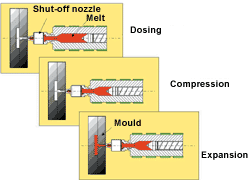High-Speed, Thin-Wall Molding Doesn't Need an Accumulator
Forget about using a gas accumulator or a special beefed-up machine to fill thin-wall parts fast. Just let the melt do all the work!
That's the message behind a new approach to high-speed, thin-wall molding developed by Engel Maschinenbau in Austria and soon to be introduced at the K 2001 show in Dusseldorf this fall. Engel (parent of Engel Canada Ltd., Guelph, Ont.) has received preliminary patent approval on what it calls the X-Melt process, a method of using energy stored in the melt to fill the melt without even moving the injection ram.
Fast fill made simpler
Engel came up with the X-Melt approach by accident. Its engineers were contemplating the trend among machine builders to use gas accumulators or electric servo drives to achieve ever faster injection rates of 1000, 1500, or even 2000 mm/sec. Engel’s staff pondered the difficult task of overcoming the inertia of the screw twice—first to achieve almost instantaneous acceleration and then to stop it “on a dime” at the boost/hold switchover point.
The researchers experimented with a mold that was specially equipped with sensors to detect the melt-front position during injection. What they found was that high screw-advance speed of 1000 mm/sec or more required a large amount of energy but produced melt-front speeds that were only one-tenth as fast as the screw movement. The dynamic energy was temporarily absorbed through compression of the melt under high injection pressure. In some high-speed experiments, the screw completed its travel before the melt barely moved.
Engel concluded that high screw-advance speed was unnecessary if the goal was to achieve high melt-front speed. If the mold were equipped with a shutoff nozzle able to withstand high pressure (14,000 to 29,000 psi or more), then it would be possible to precompress the melt with the valve closed by moving the screw to its final injection position. Once the valve is opened, the melt would expand into the mold all by itself, releasing the stored energy.
That is the essence of X-Melt. It reportedly uses only one-third to half as much energy to fill the mold. It simplifies the process by eliminating the need to determine the right injection-speed and holding-pressure profiles. (The screw does not advance beyond the precompression position.) The X-Melt technique does require some trial and error to determine the optimum screw precompression position, which depends upon pressure-volume-temperature (pvT) relationships for a particular resin. According to George Steinbichler, director of research and process technology, amorphous resins are compressible by around 10% and crystalline resins by 30% over a pressure range of 14,000 psi.
Steinbichler notes that two requirements of the process—reaching precisely repeatable screw precompression position and holding it there after the nozzle valve opens—are more suited to the capabilities of newer all-electric machines than conventional hydraulic presses. Engel will demonstrate the X-Melt process on its new “e-motion” all-electric tiebarless presses, which will also be introduced at K 2001.
Steinbichler notes that Engel and others have used a somewhat similar technique in the past that involved precompressing the melt by delaying the opening of valve gates while starting the forward injection movement of the screw. What is different about X-Melt is that the melt is pressurized to a defined level, and the screw is held at a precise position during melt expansion. These require special software, for which Engel is seeking a patent.
Early trial results
Steinbichler says molding tests were performed with an ABS/PC battery box for a mobile phone. The four-cavity mold produced parts weighing 3.2 g each with wall thickness between 0.4 and 0.5 mm. After the melt was precompressed to 34,825 psi, the mold filled in 60 millisec, compared with 80 millisec using a conventional accumulator-equipped machine and an injection speed of 1000 mm/sec. In addition, variations in part weight with X-Melt were ±0.03%, less than half the ±0.07% achieved with accumulator injection.
In another demonstration, a PBT keypad frame for a calculator was molded in two cavities. Each part weighed 8-9 g and measured about 79 x 63 mm x 0.8 mm thick. After precompression to between 29,000 and 36,000 psi using a special needle shutoff nozzle, the parts filled in 40-50 millisec through a submarine gate.
Good for small parts
“Today, the X-Melt process makes sense for parts weighing up to 50 g,” Steinbichler says. He cites micro-precision parts like electronic connectors as one likely application. For multi-cavity molds, he recommends precompressing the melt as close as possible to the cavities to avoid pressure losses in the runners. For that reason, he recommends using a hot-runner valve-gate system specially engineered for high pressures. Engel is working with Mold-Masters Ltd. of Georgetown, Ont., to develop such a system.
Read Next
Making the Circular Economy a Reality
Driven by brand owner demands and new worldwide legislation, the entire supply chain is working toward the shift to circularity, with some evidence the circular economy has already begun.
Read MoreFor PLASTICS' CEO Seaholm, NPE to Shine Light on Sustainability Successes
With advocacy, communication and sustainability as three main pillars, Seaholm leads a trade association to NPE that ‘is more active today than we have ever been.’
Read MoreSee Recyclers Close the Loop on Trade Show Production Scrap at NPE2024
A collaboration between show organizer PLASTICS, recycler CPR and size reduction experts WEIMA and Conair recovered and recycled all production scrap at NPE2024.
Read More
























